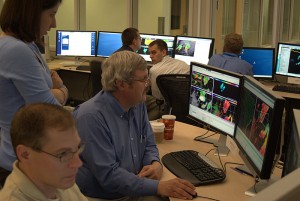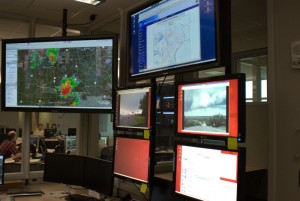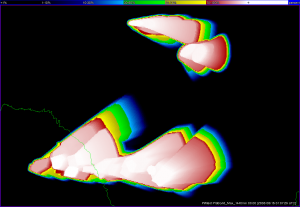Today we ran a PROBWARN IOP for the area of W to C Texas, primarily using KMAF, KDFX and KSJT, as well as the SC_Multi gridded data. We ‘sectorized’ putting DanM. and Ron P. on the northern part and Dave H. and Dan P. on the southern. Storms had begun about an hour prior to our starting time of 2130z.
The southern group spent most of their time (if not entirely) on storms forming off of “Old Faithful” on the Mexican side of the US border west of Eagle Pass, TX and moving into US territory. These storms trained, and provided some difficulty to Dan P. and Dave primarily in how best to handle trending given that some storms would increase in severe potential and others would die out.
Dan M. and Ron worked on at least one storm that transitioned from an HP supercell with primarily a hail threat to a tornado threat.
Dan P. sneaks a peek at the other team’s warnings…
We ran until 7:30 pm and had some brief discussion before letting the forecasters take a look at some convection that moved into the CASA domain around 8 pm.
A few comments regarding the IOP follows:
- It had been considered a couple of times that sectorizng based on threat type would be an iteresting exercise. I.e., one forecaster analyzes/warns on hail, while the other focuses on tornado/wind threats.
- Workload issues were again brought up. Some had a hard time keeping multiple treats on the same storm (effectively tripling their warning issuance). And even those who were keeping up were losing situational awareness due to a “round robin” type of approach where the forecaster was going from storm to storm to nudge and move on. Main loss of S.A. in this case is in the vertical structure of the storm.
- Comment was maid regarding a forecaster worrying or not completely feeling comfortable with providing the trend info. Perhaps a better tool for providing this info would help. Dan M. suggests starting with something like the GFE temporal editor.
- Other software suggestions were having a transparency slider for the ProbGrid output. having the option to sync all the threat grids for the same storm to that storm’s motion
In the discussion that followed the exercise, some time was spent considering “exceeence thresholds” for different threats. For example, issuing a high probability for hail, but a low probability for hail larger than [golfball, baseball, etc.]. This adds another degree of freedom which A) allows the forecaster to provide greater detail, but B) adds another task for the warning forecaster and (potentially) increases workload.
Other concerns were the potential/likely inconsistency between forecasters and their probabilities. Should be an interesting discussion during the debrief.
Eve was impressed at the ability to “Virtual Storm Chase”
Kevin Manross (EWP Weekly Coordinator, 12-16 May)
Addendum:
Here is the first attempt at an “accumulated” ProgGrid for yesterday’s event. Later, I’ll divide these grids into storm type and compare to Rotation Tracks, Hail Tracks, LSRs, and NWS warnings.
Greg Stumpf (EWP Operations Coordinator)



